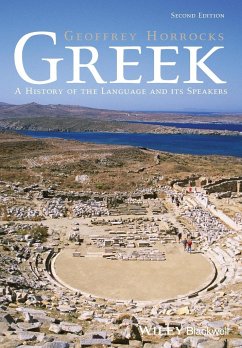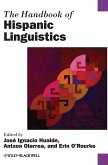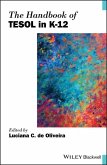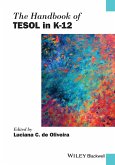- Broschiertes Buch
- Merkliste
- Auf die Merkliste
- Bewerten Bewerten
- Teilen
- Produkt teilen
- Produkterinnerung
- Produkterinnerung
This new edition of Greek: A History of the Language and its Speakers reveals the trajectory of the Greek language from the Mycenaean period of the second millennium BC to the current day.
Greek: A History of the Language and its Speakers, Second Edition reveals the trajectory of the Greek language from the Mycenaean period of the second millennium BC to the current day.
Offers a complete linguistic treatment of the history of the Greek language Updated second edition features increased coverage of the ancient evidence, as well as the roots and development of diglossia Includes maps that…mehr
Andere Kunden interessierten sich auch für
![The Handbook of Hispanic Linguistics The Handbook of Hispanic Linguistics]() The Handbook of Hispanic Linguistics268,99 €
The Handbook of Hispanic Linguistics268,99 €![The TESOL Encyclopedia of English Language Teaching, 8 Volume Set The TESOL Encyclopedia of English Language Teaching, 8 Volume Set]() TESOL International AssociationThe TESOL Encyclopedia of English Language Teaching, 8 Volume Set1.805,99 €
TESOL International AssociationThe TESOL Encyclopedia of English Language Teaching, 8 Volume Set1.805,99 €![Language, Society and Identity in Early Iceland Language, Society and Identity in Early Iceland]() Stephen Pax LeonardLanguage, Society and Identity in Early Iceland45,99 €
Stephen Pax LeonardLanguage, Society and Identity in Early Iceland45,99 €![The Handbook of TESOL in K-12 The Handbook of TESOL in K-12]() The Handbook of TESOL in K-12236,99 €
The Handbook of TESOL in K-12236,99 €![The Handbook of TESOL in K-12 The Handbook of TESOL in K-12]() The Handbook of TESOL in K-1258,99 €
The Handbook of TESOL in K-1258,99 €![The Language of Queen Elizabeth I The Language of Queen Elizabeth I]() Mel EvansThe Language of Queen Elizabeth I45,99 €
Mel EvansThe Language of Queen Elizabeth I45,99 €![Revitalising Language in Provence Revitalising Language in Provence]() James CostaRevitalising Language in Provence45,99 €
James CostaRevitalising Language in Provence45,99 €-
-
-
This new edition of Greek: A History of the Language and its Speakers reveals the trajectory of the Greek language from the Mycenaean period of the second millennium BC to the current day.
Greek: A History of the Language and its Speakers, Second Edition reveals the trajectory of the Greek language from the Mycenaean period of the second millennium BC to the current day.
Offers a complete linguistic treatment of the history of the Greek language
Updated second edition features increased coverage of the ancient evidence, as well as the roots and development of diglossia
Includes maps that clearly illustrate the distribution of ancient dialects and the geographical spread of Greek in the early Middle Ages
Hinweis: Dieser Artikel kann nur an eine deutsche Lieferadresse ausgeliefert werden.
Greek: A History of the Language and its Speakers, Second Edition reveals the trajectory of the Greek language from the Mycenaean period of the second millennium BC to the current day.
Offers a complete linguistic treatment of the history of the Greek language
Updated second edition features increased coverage of the ancient evidence, as well as the roots and development of diglossia
Includes maps that clearly illustrate the distribution of ancient dialects and the geographical spread of Greek in the early Middle Ages
Hinweis: Dieser Artikel kann nur an eine deutsche Lieferadresse ausgeliefert werden.
Produktdetails
- Produktdetails
- Verlag: Wiley & Sons
- 2. Aufl.
- Seitenzahl: 528
- Erscheinungstermin: 3. Januar 2014
- Englisch
- Abmessung: 244mm x 170mm x 29mm
- Gewicht: 794g
- ISBN-13: 9781118785157
- ISBN-10: 1118785150
- Artikelnr.: 39764851
- Herstellerkennzeichnung
- Libri GmbH
- Europaallee 1
- 36244 Bad Hersfeld
- gpsr@libri.de
- Verlag: Wiley & Sons
- 2. Aufl.
- Seitenzahl: 528
- Erscheinungstermin: 3. Januar 2014
- Englisch
- Abmessung: 244mm x 170mm x 29mm
- Gewicht: 794g
- ISBN-13: 9781118785157
- ISBN-10: 1118785150
- Artikelnr.: 39764851
- Herstellerkennzeichnung
- Libri GmbH
- Europaallee 1
- 36244 Bad Hersfeld
- gpsr@libri.de
Geoffrey Horrocks is Professor of Comparative Philology at the University of Cambridge, UK, and Fellow of St John's College. His previous books include Space and Time in Homer (1981), Generative Grammar (1987), Greek: A History of the Language and its Speakers (1997), and The Blackwell History of the Latin Language (with James Clackson, 2007).
Preface to the First Edition xii
Preface to the Second Edition xv
IPA Chart xvii
The Greek Alphabet xviii
Introduction: The Scope and Purpose of This Book 1
Part I Ancient Greek: From Mycenae to the Roman Empire 7
1 The Ancient Greek Dialects 9
1.1 The Coming of the 'Greeks' to Greece 9
1.2 The Earliest Records: Mycenaean Greek 10
1.3 Greek Dialect Relations and the Place of Mycenaean 13
1.4 Some Examples 24
1.4.1 Some basic dialect characteristics 24
1.4.2 West Greek 28
(a) Laconian 28
(b) Cretan 29
(c) Elean 30
(d) Phocian 31
1.4.3 Aeolic 32
(a) Boeotian 32
(b) Thessalian 33
(c) Lesbian 34
1.4.4 East Greek 36
(a) Arcadian 36
(b) Ionic 37
(c) Attic 40
2 Classical Greek: Official and Literary 'Standards' 43
2.1 Introduction 43
2.2 The Language of Homer and its Influence 44
2.2.1 Ionian epic 44
2.2.2 Ionian elegy and iambus 49
2.2.3 Personal lyric 50
2.2.4 Choral lyric 53
2.2.5 Athenian drama 56
2.3 Official and Literary Ionic 60
3 The Rise of Attic 67
3.1 Attic as a Literary Standard 67
3.2 'Great Attic' as an Administrative Language 73
4 Greek in the Hellenistic World 79
4.1 Introduction 79
4.2 The Koine as an Extension of Great Attic 80
4.3 The Impact and Status of the Koine 83
4.4 The Fate of the Ancient Greek Dialects 84
4.4.1 Introduction 84
4.4.2 Koineization: the case of Boeotian 84
4.4.3 Doric koines: Tsakonian 87
4.5 The Koine in the Hellenistic Kingdoms 88
4.6 The Koine as an Official Language 89
4.6.1 Introduction 89
4.6.2 Macedonian Koine: the development of infinitival constructions 90
4.6.3 The articular infinitive 94
4.7 Language and Literature in the Hellenistic World: The Koine as a
Literary Dialect 96
4.7.1 Introduction 96
4.7.2 Historiography: Polybius 97
4.7.3 The Koine as the language of technical prose 98
4.7.4 Reaction against the Koine: Hellenistic poetry 98
4.7.5 Reaction against the Koine: Asianism and Atticism 99
4.7.6 Popular literature: romances 100
4.7.7 Drama: the 'new' Attic comedy and the mime 101
4.7.8 Jewish literature: the Septuagint 106
4.8 Clitic Pronouns and the Shift Towards VS Word Order 108
4.9 Analogical Pressure on the Strong Aorist Paradigm 109
4.10 The Spoken Koine: Regional Diversity 110
4.10.1 Introduction 110
4.10.2 Egypt 111
4.10.3 Asia Minor 113
4.11 Private Inscriptions and Papyri: Some Major Trends 114
4.11.1 Introduction: datives, future periphrases, the nom-acc plural of
consonant-stems 114
4.11.2 Phonological developments 117
4.11.3 Other morphological developments: partial merger of the 1st and 3rd
declensions 120
4.12 Conclusion 122
5 Greek in the Roman Empire 124
5.1 Roman Domination 124
5.2 The Fate of Greek 125
5.3 The Impact of Bilingualism: Greek and Latin in Contact 126
5.4 Roman Attitudes to Greek Culture 132
5.5 Atticism and the Second Sophistic 133
5.6 Atticist Grammars and Lexica: Aelius Aristides 137
5.7 The Official Koine in the Roman Republican Period 141
5.8 Past-Tense Morphology 143
5.9 Official Writing of the Roman Imperial Period 144
5.10 'Colloquial' Literature 146
5.10.1 Epictetus 146
5.10.2 The New Testament 147
5.11 Later Christian Literature: Stylistic Levels 152
5.11.1 The Apostolic Fathers 152
5.11.2 The impact of Atticism 155
5.11.3 Callinicus and Theodoret 156
6 Spoken Koine in the Roman Period 160
6.1 Introduction 160
6.2 Summary of the Principal Developments in the Vowel System 160
6.3 Some Illustrative Examples 163
6.3.1 Athenian Attic 163
6.3.2 Egyptian Koine 165
6.4 The Development of the Consonant System 170
6.5 Some Egyptian Texts 172
6.5.1 Letter 1: clitic pronouns and word order, control verbs with i{na
['ina]-complements 172
6.5.2 Letter 2: 'short' 2nd-declension forms, the merger of aorist and
perfect 174
6.5.3 Letter 3: the decline of 3rd-declension participles 178
6.5.4 Letter 4: the decline of the dative 183
6.6 Conclusion 187
Part II Byzantium: From Constantine I to Mehmet the Conqueror 189
7 Historical Prelude 191
7.1 The Later Roman Empire 191
7.2 The Age of Transition: Ioustinianós and the Arab Conquests 194
7.3 The Middle Byzantine Period: Iconoclasm, Renaissance and Decline 197
7.4 The Late Byzantine Period: Stabilization, Defeat and Fall 200
8 Greek in the Byzantine Empire: The Major Issues 207
8.1 Introduction 207
8.2 Greek and Other Languages in the Early Byzantine Period 207
8.3 The Prestige of Greek 210
8.4 Greek in the Later Empire 212
8.4.1 Introduction 212
8.4.2 Byzantine Atticism 213
8.4.3 The first experiments with the vernacular 214
8.4.4 The vernacular literature of the 14th and 15th centuries 216
8.4.5 The romances 217
8.4.6 Other vernacular material 219
8.5 'The Koine' in Byzantium 220
8.5.1 The inheritance from antiquity 220
8.5.2 Academic and ecclesiastical Greek 220
8.5.3 Official and administrative Greek 221
8.5.4 Practical writing in the middle period 222
8.5.5 Chronicles 222
8.5.6 Christian exegetical literature and hagiography 225
8.5.7 A new written standard in the later empire 226
8.6 The Balkan Sprachbund: Future Formations 227
8.7 Conclusion 229
9 Byzantine Belles Lettres 231
9.1 Introduction 231
9.2 The Early Period: Prokópios (First Half of the 6th Century) 231
9.3 The Middle Period: Michaél Psellós (1018-1078 or 1096) 233
9.4 The Modal Imperfect 237
9.5 The Late Period: Anna Komnené (1083-c.1153) 238
9.6 After the Fall: Michaél Kritóboulos (15th Century) 240
9.7 Conclusion 242
10 The Written Koine in Byzantium 244
10.1 Introduction 244
10.2 Chronicles in the Early and Middle Periods 245
10.2.1 Malálas (c.491-c.578): generics 245
10.2.2 Theophánes the Confessor (c.760-818) 251
10.3 Hagiography and Exegetical Works 253
10.3.1 Ioánnes Móschos (c.550-619) 253
10.3.2 St Germanós (c.640-733) 256
10.4 Paraenetic Literature of the Middle Period 258
10.4.1 Konstantínos VII Porphyrogénnetos (905-59) 258
10.4.2 Kekauménos (11th century) 262
10.5 The Metaphrases of the Palaiologan Period 264
10.6 Academic Greek in the Late Period: Máximos Planoúdes (c.1255-c.1305)
268
10.7 Official Greek of the Later Empire 270
10.8 Conclusion 271
11 Spoken Greek in the Byzantine Empire: The Principal Developments 273
11.1 Introduction 273
11.2 The Completion of Sound Changes Beginning in Antiquity 274
11.3 Grammatical Consequences of Aphaeresis 277
11.4 Old and New Patterns of Subordination: Clitic Pronouns and VSO Order
277
11.5 Dialect Diversity in Medieval Greek 281
11.6 Later Phonetic and Phonological Developments 281
11.7 Nominal Morphology and Syntax 284
11.7.1 The dative case, prepositional phrases 284
11.7.2 Feminine nouns of the 1st declension: paradigm standardization 285
11.7.3 Masculine nouns of the 1st declension: paradigm standardization 286
11.7.4 Interplay between the 1st and 3rd declensions: imparisyllabic
paradigms 286
11.7.5 Neuters 288
11.7.6 The definite article 289
11.7.7 Adjectives 289
11.7.8 Pronouns 292
(a) Indefinite pronouns 292
(b) Interrogative pronouns 293
(c) Relative pronouns 293
(d) Demonstrative pronouns 295
(e) Personal pronouns 296
11.8 Verb Morphology and Syntax 296
11.8.1 The infinitive 296
11.8.2 Participles 297
11.8.3 Futures and conditionals, pluperfects and perfects 298
11.8.4 The spread of k-aorists: the aorist passive 302
11.8.5 Imperfective stem formation 303
(a) The fate of the -mi [-mi] verbs 303
(b) Nasal suffixes 305
(c) The suffixes -avzw [-'azo]/-ivzw [-'izo] 307
(d) The suffix -euvw [-'evo] and its influence: verbs in -ptw [-pto] 312
(e) The contract verbs 313
11.8.6 Personal endings 316
(a) Indicative and subjunctive 317
(b) Past-tense morphology: active and aorist middle/ passive; the augment
318
(c) The active paradigm: present tense 319
(d) The middle/passive paradigm: present tense 320
(e) The middle/passive paradigm: the imperfect 320
11.9 Conclusion 323
12 Texts in the 'Vernacular' 325
12.1 The Early and Middle Periods 325
12.1.1 Introduction 325
12.1.2 The Protobulgarian inscriptions 325
12.1.3 Acclamations: origins of the 'political' verse form 327
12.2 Vernacular Literature of the 12th Century 333
12.2.1 The epic of Digenés Akrítes 333
12.2.2 Ptochopródromos 337
12.3 The 14th and 15th Centuries: The Palaiologan Court and Frankish Rule
342
12.3.1 The original romances of the Palaiologan period 342
12.3.2 Greek-Romance contact: perfects/pluperfects, negative polarity,
clitics 345
12.3.3 The Chronicle of the Morea 349
12.3.4 The translated romances 357
12.4 The First Dialect Literature: Cyprus and Crete 360
12.4.1 Introduction 360
12.4.2 Early dialect literature in Cyprus: Machairás' chronicle 362
12.4.3 Early vernacular literature in Crete 366
12.5 Conclusion 368
Part III Modern Greek: From the Ottoman Empire to the European Union 371
13 Ottoman Rule and the War of Independence 373
13.1 The Early Years 373
13.2 Ottoman Decline 374
13.3 Revolution and Independence 377
14 Spoken Greek in the Ottoman Period 379
14.1 The Impact of Turkish 379
14.2 The Spoken Dialects of Modern Greek 381
14.2.1 Introduction: diversification, and the basis for a modern spoken
standard 381
14.2.2 Local vernaculars in the central region; Sofianós' grammar and the
educated standard 384
14.2.3 Greek in the west: the South Italian dialects 388
14.2.4 Greek in the south and south-east: the Dodecanese, Cyprus and Crete
391
14.2.5 Greek in the east: Pontus and Cappadocia 398
14.2.6 The northern dialects 404
14.3 Popular Culture in the Turkish Period: The Folk Songs 406
15 Written Greek in the Turkish Period 413
15.1 Continuity 413
15.2 The Impact of the Enlightenment 419
15.3 Contemporary 'Demotic' 423
15.4 The Roots of the 'Language Question' 426
16 The History of the Modern Greek State 428
16.1 Irredentism: Triumph and Disaster 428
16.2 Dictatorship and War 431
16.3 Recovery, the Colonels and the Restoration of Democracy 433
17 The 'Language Question' and its Resolution 438
17.1 Koraís 438
17.2 The Roots of Demoticism: Solomós and the Ionian Islands 442
17.3 The Rise of Katharévousa 445
17.4 Reaction: Psycháris and the Demoticist Programme 446
17.5 The Progress of Demoticism 454
17.6 The 20th Century: Crisis and Resolution 456
17.7 Standard Modern Greek 462
17.8 A Range of Styles 466
Bibliography 471
Index 493
Preface to the Second Edition xv
IPA Chart xvii
The Greek Alphabet xviii
Introduction: The Scope and Purpose of This Book 1
Part I Ancient Greek: From Mycenae to the Roman Empire 7
1 The Ancient Greek Dialects 9
1.1 The Coming of the 'Greeks' to Greece 9
1.2 The Earliest Records: Mycenaean Greek 10
1.3 Greek Dialect Relations and the Place of Mycenaean 13
1.4 Some Examples 24
1.4.1 Some basic dialect characteristics 24
1.4.2 West Greek 28
(a) Laconian 28
(b) Cretan 29
(c) Elean 30
(d) Phocian 31
1.4.3 Aeolic 32
(a) Boeotian 32
(b) Thessalian 33
(c) Lesbian 34
1.4.4 East Greek 36
(a) Arcadian 36
(b) Ionic 37
(c) Attic 40
2 Classical Greek: Official and Literary 'Standards' 43
2.1 Introduction 43
2.2 The Language of Homer and its Influence 44
2.2.1 Ionian epic 44
2.2.2 Ionian elegy and iambus 49
2.2.3 Personal lyric 50
2.2.4 Choral lyric 53
2.2.5 Athenian drama 56
2.3 Official and Literary Ionic 60
3 The Rise of Attic 67
3.1 Attic as a Literary Standard 67
3.2 'Great Attic' as an Administrative Language 73
4 Greek in the Hellenistic World 79
4.1 Introduction 79
4.2 The Koine as an Extension of Great Attic 80
4.3 The Impact and Status of the Koine 83
4.4 The Fate of the Ancient Greek Dialects 84
4.4.1 Introduction 84
4.4.2 Koineization: the case of Boeotian 84
4.4.3 Doric koines: Tsakonian 87
4.5 The Koine in the Hellenistic Kingdoms 88
4.6 The Koine as an Official Language 89
4.6.1 Introduction 89
4.6.2 Macedonian Koine: the development of infinitival constructions 90
4.6.3 The articular infinitive 94
4.7 Language and Literature in the Hellenistic World: The Koine as a
Literary Dialect 96
4.7.1 Introduction 96
4.7.2 Historiography: Polybius 97
4.7.3 The Koine as the language of technical prose 98
4.7.4 Reaction against the Koine: Hellenistic poetry 98
4.7.5 Reaction against the Koine: Asianism and Atticism 99
4.7.6 Popular literature: romances 100
4.7.7 Drama: the 'new' Attic comedy and the mime 101
4.7.8 Jewish literature: the Septuagint 106
4.8 Clitic Pronouns and the Shift Towards VS Word Order 108
4.9 Analogical Pressure on the Strong Aorist Paradigm 109
4.10 The Spoken Koine: Regional Diversity 110
4.10.1 Introduction 110
4.10.2 Egypt 111
4.10.3 Asia Minor 113
4.11 Private Inscriptions and Papyri: Some Major Trends 114
4.11.1 Introduction: datives, future periphrases, the nom-acc plural of
consonant-stems 114
4.11.2 Phonological developments 117
4.11.3 Other morphological developments: partial merger of the 1st and 3rd
declensions 120
4.12 Conclusion 122
5 Greek in the Roman Empire 124
5.1 Roman Domination 124
5.2 The Fate of Greek 125
5.3 The Impact of Bilingualism: Greek and Latin in Contact 126
5.4 Roman Attitudes to Greek Culture 132
5.5 Atticism and the Second Sophistic 133
5.6 Atticist Grammars and Lexica: Aelius Aristides 137
5.7 The Official Koine in the Roman Republican Period 141
5.8 Past-Tense Morphology 143
5.9 Official Writing of the Roman Imperial Period 144
5.10 'Colloquial' Literature 146
5.10.1 Epictetus 146
5.10.2 The New Testament 147
5.11 Later Christian Literature: Stylistic Levels 152
5.11.1 The Apostolic Fathers 152
5.11.2 The impact of Atticism 155
5.11.3 Callinicus and Theodoret 156
6 Spoken Koine in the Roman Period 160
6.1 Introduction 160
6.2 Summary of the Principal Developments in the Vowel System 160
6.3 Some Illustrative Examples 163
6.3.1 Athenian Attic 163
6.3.2 Egyptian Koine 165
6.4 The Development of the Consonant System 170
6.5 Some Egyptian Texts 172
6.5.1 Letter 1: clitic pronouns and word order, control verbs with i{na
['ina]-complements 172
6.5.2 Letter 2: 'short' 2nd-declension forms, the merger of aorist and
perfect 174
6.5.3 Letter 3: the decline of 3rd-declension participles 178
6.5.4 Letter 4: the decline of the dative 183
6.6 Conclusion 187
Part II Byzantium: From Constantine I to Mehmet the Conqueror 189
7 Historical Prelude 191
7.1 The Later Roman Empire 191
7.2 The Age of Transition: Ioustinianós and the Arab Conquests 194
7.3 The Middle Byzantine Period: Iconoclasm, Renaissance and Decline 197
7.4 The Late Byzantine Period: Stabilization, Defeat and Fall 200
8 Greek in the Byzantine Empire: The Major Issues 207
8.1 Introduction 207
8.2 Greek and Other Languages in the Early Byzantine Period 207
8.3 The Prestige of Greek 210
8.4 Greek in the Later Empire 212
8.4.1 Introduction 212
8.4.2 Byzantine Atticism 213
8.4.3 The first experiments with the vernacular 214
8.4.4 The vernacular literature of the 14th and 15th centuries 216
8.4.5 The romances 217
8.4.6 Other vernacular material 219
8.5 'The Koine' in Byzantium 220
8.5.1 The inheritance from antiquity 220
8.5.2 Academic and ecclesiastical Greek 220
8.5.3 Official and administrative Greek 221
8.5.4 Practical writing in the middle period 222
8.5.5 Chronicles 222
8.5.6 Christian exegetical literature and hagiography 225
8.5.7 A new written standard in the later empire 226
8.6 The Balkan Sprachbund: Future Formations 227
8.7 Conclusion 229
9 Byzantine Belles Lettres 231
9.1 Introduction 231
9.2 The Early Period: Prokópios (First Half of the 6th Century) 231
9.3 The Middle Period: Michaél Psellós (1018-1078 or 1096) 233
9.4 The Modal Imperfect 237
9.5 The Late Period: Anna Komnené (1083-c.1153) 238
9.6 After the Fall: Michaél Kritóboulos (15th Century) 240
9.7 Conclusion 242
10 The Written Koine in Byzantium 244
10.1 Introduction 244
10.2 Chronicles in the Early and Middle Periods 245
10.2.1 Malálas (c.491-c.578): generics 245
10.2.2 Theophánes the Confessor (c.760-818) 251
10.3 Hagiography and Exegetical Works 253
10.3.1 Ioánnes Móschos (c.550-619) 253
10.3.2 St Germanós (c.640-733) 256
10.4 Paraenetic Literature of the Middle Period 258
10.4.1 Konstantínos VII Porphyrogénnetos (905-59) 258
10.4.2 Kekauménos (11th century) 262
10.5 The Metaphrases of the Palaiologan Period 264
10.6 Academic Greek in the Late Period: Máximos Planoúdes (c.1255-c.1305)
268
10.7 Official Greek of the Later Empire 270
10.8 Conclusion 271
11 Spoken Greek in the Byzantine Empire: The Principal Developments 273
11.1 Introduction 273
11.2 The Completion of Sound Changes Beginning in Antiquity 274
11.3 Grammatical Consequences of Aphaeresis 277
11.4 Old and New Patterns of Subordination: Clitic Pronouns and VSO Order
277
11.5 Dialect Diversity in Medieval Greek 281
11.6 Later Phonetic and Phonological Developments 281
11.7 Nominal Morphology and Syntax 284
11.7.1 The dative case, prepositional phrases 284
11.7.2 Feminine nouns of the 1st declension: paradigm standardization 285
11.7.3 Masculine nouns of the 1st declension: paradigm standardization 286
11.7.4 Interplay between the 1st and 3rd declensions: imparisyllabic
paradigms 286
11.7.5 Neuters 288
11.7.6 The definite article 289
11.7.7 Adjectives 289
11.7.8 Pronouns 292
(a) Indefinite pronouns 292
(b) Interrogative pronouns 293
(c) Relative pronouns 293
(d) Demonstrative pronouns 295
(e) Personal pronouns 296
11.8 Verb Morphology and Syntax 296
11.8.1 The infinitive 296
11.8.2 Participles 297
11.8.3 Futures and conditionals, pluperfects and perfects 298
11.8.4 The spread of k-aorists: the aorist passive 302
11.8.5 Imperfective stem formation 303
(a) The fate of the -mi [-mi] verbs 303
(b) Nasal suffixes 305
(c) The suffixes -avzw [-'azo]/-ivzw [-'izo] 307
(d) The suffix -euvw [-'evo] and its influence: verbs in -ptw [-pto] 312
(e) The contract verbs 313
11.8.6 Personal endings 316
(a) Indicative and subjunctive 317
(b) Past-tense morphology: active and aorist middle/ passive; the augment
318
(c) The active paradigm: present tense 319
(d) The middle/passive paradigm: present tense 320
(e) The middle/passive paradigm: the imperfect 320
11.9 Conclusion 323
12 Texts in the 'Vernacular' 325
12.1 The Early and Middle Periods 325
12.1.1 Introduction 325
12.1.2 The Protobulgarian inscriptions 325
12.1.3 Acclamations: origins of the 'political' verse form 327
12.2 Vernacular Literature of the 12th Century 333
12.2.1 The epic of Digenés Akrítes 333
12.2.2 Ptochopródromos 337
12.3 The 14th and 15th Centuries: The Palaiologan Court and Frankish Rule
342
12.3.1 The original romances of the Palaiologan period 342
12.3.2 Greek-Romance contact: perfects/pluperfects, negative polarity,
clitics 345
12.3.3 The Chronicle of the Morea 349
12.3.4 The translated romances 357
12.4 The First Dialect Literature: Cyprus and Crete 360
12.4.1 Introduction 360
12.4.2 Early dialect literature in Cyprus: Machairás' chronicle 362
12.4.3 Early vernacular literature in Crete 366
12.5 Conclusion 368
Part III Modern Greek: From the Ottoman Empire to the European Union 371
13 Ottoman Rule and the War of Independence 373
13.1 The Early Years 373
13.2 Ottoman Decline 374
13.3 Revolution and Independence 377
14 Spoken Greek in the Ottoman Period 379
14.1 The Impact of Turkish 379
14.2 The Spoken Dialects of Modern Greek 381
14.2.1 Introduction: diversification, and the basis for a modern spoken
standard 381
14.2.2 Local vernaculars in the central region; Sofianós' grammar and the
educated standard 384
14.2.3 Greek in the west: the South Italian dialects 388
14.2.4 Greek in the south and south-east: the Dodecanese, Cyprus and Crete
391
14.2.5 Greek in the east: Pontus and Cappadocia 398
14.2.6 The northern dialects 404
14.3 Popular Culture in the Turkish Period: The Folk Songs 406
15 Written Greek in the Turkish Period 413
15.1 Continuity 413
15.2 The Impact of the Enlightenment 419
15.3 Contemporary 'Demotic' 423
15.4 The Roots of the 'Language Question' 426
16 The History of the Modern Greek State 428
16.1 Irredentism: Triumph and Disaster 428
16.2 Dictatorship and War 431
16.3 Recovery, the Colonels and the Restoration of Democracy 433
17 The 'Language Question' and its Resolution 438
17.1 Koraís 438
17.2 The Roots of Demoticism: Solomós and the Ionian Islands 442
17.3 The Rise of Katharévousa 445
17.4 Reaction: Psycháris and the Demoticist Programme 446
17.5 The Progress of Demoticism 454
17.6 The 20th Century: Crisis and Resolution 456
17.7 Standard Modern Greek 462
17.8 A Range of Styles 466
Bibliography 471
Index 493
Preface to the First Edition xii
Preface to the Second Edition xv
IPA Chart xvii
The Greek Alphabet xviii
Introduction: The Scope and Purpose of This Book 1
Part I Ancient Greek: From Mycenae to the Roman Empire 7
1 The Ancient Greek Dialects 9
1.1 The Coming of the 'Greeks' to Greece 9
1.2 The Earliest Records: Mycenaean Greek 10
1.3 Greek Dialect Relations and the Place of Mycenaean 13
1.4 Some Examples 24
1.4.1 Some basic dialect characteristics 24
1.4.2 West Greek 28
(a) Laconian 28
(b) Cretan 29
(c) Elean 30
(d) Phocian 31
1.4.3 Aeolic 32
(a) Boeotian 32
(b) Thessalian 33
(c) Lesbian 34
1.4.4 East Greek 36
(a) Arcadian 36
(b) Ionic 37
(c) Attic 40
2 Classical Greek: Official and Literary 'Standards' 43
2.1 Introduction 43
2.2 The Language of Homer and its Influence 44
2.2.1 Ionian epic 44
2.2.2 Ionian elegy and iambus 49
2.2.3 Personal lyric 50
2.2.4 Choral lyric 53
2.2.5 Athenian drama 56
2.3 Official and Literary Ionic 60
3 The Rise of Attic 67
3.1 Attic as a Literary Standard 67
3.2 'Great Attic' as an Administrative Language 73
4 Greek in the Hellenistic World 79
4.1 Introduction 79
4.2 The Koine as an Extension of Great Attic 80
4.3 The Impact and Status of the Koine 83
4.4 The Fate of the Ancient Greek Dialects 84
4.4.1 Introduction 84
4.4.2 Koineization: the case of Boeotian 84
4.4.3 Doric koines: Tsakonian 87
4.5 The Koine in the Hellenistic Kingdoms 88
4.6 The Koine as an Official Language 89
4.6.1 Introduction 89
4.6.2 Macedonian Koine: the development of infinitival constructions 90
4.6.3 The articular infinitive 94
4.7 Language and Literature in the Hellenistic World: The Koine as a
Literary Dialect 96
4.7.1 Introduction 96
4.7.2 Historiography: Polybius 97
4.7.3 The Koine as the language of technical prose 98
4.7.4 Reaction against the Koine: Hellenistic poetry 98
4.7.5 Reaction against the Koine: Asianism and Atticism 99
4.7.6 Popular literature: romances 100
4.7.7 Drama: the 'new' Attic comedy and the mime 101
4.7.8 Jewish literature: the Septuagint 106
4.8 Clitic Pronouns and the Shift Towards VS Word Order 108
4.9 Analogical Pressure on the Strong Aorist Paradigm 109
4.10 The Spoken Koine: Regional Diversity 110
4.10.1 Introduction 110
4.10.2 Egypt 111
4.10.3 Asia Minor 113
4.11 Private Inscriptions and Papyri: Some Major Trends 114
4.11.1 Introduction: datives, future periphrases, the nom-acc plural of
consonant-stems 114
4.11.2 Phonological developments 117
4.11.3 Other morphological developments: partial merger of the 1st and 3rd
declensions 120
4.12 Conclusion 122
5 Greek in the Roman Empire 124
5.1 Roman Domination 124
5.2 The Fate of Greek 125
5.3 The Impact of Bilingualism: Greek and Latin in Contact 126
5.4 Roman Attitudes to Greek Culture 132
5.5 Atticism and the Second Sophistic 133
5.6 Atticist Grammars and Lexica: Aelius Aristides 137
5.7 The Official Koine in the Roman Republican Period 141
5.8 Past-Tense Morphology 143
5.9 Official Writing of the Roman Imperial Period 144
5.10 'Colloquial' Literature 146
5.10.1 Epictetus 146
5.10.2 The New Testament 147
5.11 Later Christian Literature: Stylistic Levels 152
5.11.1 The Apostolic Fathers 152
5.11.2 The impact of Atticism 155
5.11.3 Callinicus and Theodoret 156
6 Spoken Koine in the Roman Period 160
6.1 Introduction 160
6.2 Summary of the Principal Developments in the Vowel System 160
6.3 Some Illustrative Examples 163
6.3.1 Athenian Attic 163
6.3.2 Egyptian Koine 165
6.4 The Development of the Consonant System 170
6.5 Some Egyptian Texts 172
6.5.1 Letter 1: clitic pronouns and word order, control verbs with i{na
['ina]-complements 172
6.5.2 Letter 2: 'short' 2nd-declension forms, the merger of aorist and
perfect 174
6.5.3 Letter 3: the decline of 3rd-declension participles 178
6.5.4 Letter 4: the decline of the dative 183
6.6 Conclusion 187
Part II Byzantium: From Constantine I to Mehmet the Conqueror 189
7 Historical Prelude 191
7.1 The Later Roman Empire 191
7.2 The Age of Transition: Ioustinianós and the Arab Conquests 194
7.3 The Middle Byzantine Period: Iconoclasm, Renaissance and Decline 197
7.4 The Late Byzantine Period: Stabilization, Defeat and Fall 200
8 Greek in the Byzantine Empire: The Major Issues 207
8.1 Introduction 207
8.2 Greek and Other Languages in the Early Byzantine Period 207
8.3 The Prestige of Greek 210
8.4 Greek in the Later Empire 212
8.4.1 Introduction 212
8.4.2 Byzantine Atticism 213
8.4.3 The first experiments with the vernacular 214
8.4.4 The vernacular literature of the 14th and 15th centuries 216
8.4.5 The romances 217
8.4.6 Other vernacular material 219
8.5 'The Koine' in Byzantium 220
8.5.1 The inheritance from antiquity 220
8.5.2 Academic and ecclesiastical Greek 220
8.5.3 Official and administrative Greek 221
8.5.4 Practical writing in the middle period 222
8.5.5 Chronicles 222
8.5.6 Christian exegetical literature and hagiography 225
8.5.7 A new written standard in the later empire 226
8.6 The Balkan Sprachbund: Future Formations 227
8.7 Conclusion 229
9 Byzantine Belles Lettres 231
9.1 Introduction 231
9.2 The Early Period: Prokópios (First Half of the 6th Century) 231
9.3 The Middle Period: Michaél Psellós (1018-1078 or 1096) 233
9.4 The Modal Imperfect 237
9.5 The Late Period: Anna Komnené (1083-c.1153) 238
9.6 After the Fall: Michaél Kritóboulos (15th Century) 240
9.7 Conclusion 242
10 The Written Koine in Byzantium 244
10.1 Introduction 244
10.2 Chronicles in the Early and Middle Periods 245
10.2.1 Malálas (c.491-c.578): generics 245
10.2.2 Theophánes the Confessor (c.760-818) 251
10.3 Hagiography and Exegetical Works 253
10.3.1 Ioánnes Móschos (c.550-619) 253
10.3.2 St Germanós (c.640-733) 256
10.4 Paraenetic Literature of the Middle Period 258
10.4.1 Konstantínos VII Porphyrogénnetos (905-59) 258
10.4.2 Kekauménos (11th century) 262
10.5 The Metaphrases of the Palaiologan Period 264
10.6 Academic Greek in the Late Period: Máximos Planoúdes (c.1255-c.1305)
268
10.7 Official Greek of the Later Empire 270
10.8 Conclusion 271
11 Spoken Greek in the Byzantine Empire: The Principal Developments 273
11.1 Introduction 273
11.2 The Completion of Sound Changes Beginning in Antiquity 274
11.3 Grammatical Consequences of Aphaeresis 277
11.4 Old and New Patterns of Subordination: Clitic Pronouns and VSO Order
277
11.5 Dialect Diversity in Medieval Greek 281
11.6 Later Phonetic and Phonological Developments 281
11.7 Nominal Morphology and Syntax 284
11.7.1 The dative case, prepositional phrases 284
11.7.2 Feminine nouns of the 1st declension: paradigm standardization 285
11.7.3 Masculine nouns of the 1st declension: paradigm standardization 286
11.7.4 Interplay between the 1st and 3rd declensions: imparisyllabic
paradigms 286
11.7.5 Neuters 288
11.7.6 The definite article 289
11.7.7 Adjectives 289
11.7.8 Pronouns 292
(a) Indefinite pronouns 292
(b) Interrogative pronouns 293
(c) Relative pronouns 293
(d) Demonstrative pronouns 295
(e) Personal pronouns 296
11.8 Verb Morphology and Syntax 296
11.8.1 The infinitive 296
11.8.2 Participles 297
11.8.3 Futures and conditionals, pluperfects and perfects 298
11.8.4 The spread of k-aorists: the aorist passive 302
11.8.5 Imperfective stem formation 303
(a) The fate of the -mi [-mi] verbs 303
(b) Nasal suffixes 305
(c) The suffixes -avzw [-'azo]/-ivzw [-'izo] 307
(d) The suffix -euvw [-'evo] and its influence: verbs in -ptw [-pto] 312
(e) The contract verbs 313
11.8.6 Personal endings 316
(a) Indicative and subjunctive 317
(b) Past-tense morphology: active and aorist middle/ passive; the augment
318
(c) The active paradigm: present tense 319
(d) The middle/passive paradigm: present tense 320
(e) The middle/passive paradigm: the imperfect 320
11.9 Conclusion 323
12 Texts in the 'Vernacular' 325
12.1 The Early and Middle Periods 325
12.1.1 Introduction 325
12.1.2 The Protobulgarian inscriptions 325
12.1.3 Acclamations: origins of the 'political' verse form 327
12.2 Vernacular Literature of the 12th Century 333
12.2.1 The epic of Digenés Akrítes 333
12.2.2 Ptochopródromos 337
12.3 The 14th and 15th Centuries: The Palaiologan Court and Frankish Rule
342
12.3.1 The original romances of the Palaiologan period 342
12.3.2 Greek-Romance contact: perfects/pluperfects, negative polarity,
clitics 345
12.3.3 The Chronicle of the Morea 349
12.3.4 The translated romances 357
12.4 The First Dialect Literature: Cyprus and Crete 360
12.4.1 Introduction 360
12.4.2 Early dialect literature in Cyprus: Machairás' chronicle 362
12.4.3 Early vernacular literature in Crete 366
12.5 Conclusion 368
Part III Modern Greek: From the Ottoman Empire to the European Union 371
13 Ottoman Rule and the War of Independence 373
13.1 The Early Years 373
13.2 Ottoman Decline 374
13.3 Revolution and Independence 377
14 Spoken Greek in the Ottoman Period 379
14.1 The Impact of Turkish 379
14.2 The Spoken Dialects of Modern Greek 381
14.2.1 Introduction: diversification, and the basis for a modern spoken
standard 381
14.2.2 Local vernaculars in the central region; Sofianós' grammar and the
educated standard 384
14.2.3 Greek in the west: the South Italian dialects 388
14.2.4 Greek in the south and south-east: the Dodecanese, Cyprus and Crete
391
14.2.5 Greek in the east: Pontus and Cappadocia 398
14.2.6 The northern dialects 404
14.3 Popular Culture in the Turkish Period: The Folk Songs 406
15 Written Greek in the Turkish Period 413
15.1 Continuity 413
15.2 The Impact of the Enlightenment 419
15.3 Contemporary 'Demotic' 423
15.4 The Roots of the 'Language Question' 426
16 The History of the Modern Greek State 428
16.1 Irredentism: Triumph and Disaster 428
16.2 Dictatorship and War 431
16.3 Recovery, the Colonels and the Restoration of Democracy 433
17 The 'Language Question' and its Resolution 438
17.1 Koraís 438
17.2 The Roots of Demoticism: Solomós and the Ionian Islands 442
17.3 The Rise of Katharévousa 445
17.4 Reaction: Psycháris and the Demoticist Programme 446
17.5 The Progress of Demoticism 454
17.6 The 20th Century: Crisis and Resolution 456
17.7 Standard Modern Greek 462
17.8 A Range of Styles 466
Bibliography 471
Index 493
Preface to the Second Edition xv
IPA Chart xvii
The Greek Alphabet xviii
Introduction: The Scope and Purpose of This Book 1
Part I Ancient Greek: From Mycenae to the Roman Empire 7
1 The Ancient Greek Dialects 9
1.1 The Coming of the 'Greeks' to Greece 9
1.2 The Earliest Records: Mycenaean Greek 10
1.3 Greek Dialect Relations and the Place of Mycenaean 13
1.4 Some Examples 24
1.4.1 Some basic dialect characteristics 24
1.4.2 West Greek 28
(a) Laconian 28
(b) Cretan 29
(c) Elean 30
(d) Phocian 31
1.4.3 Aeolic 32
(a) Boeotian 32
(b) Thessalian 33
(c) Lesbian 34
1.4.4 East Greek 36
(a) Arcadian 36
(b) Ionic 37
(c) Attic 40
2 Classical Greek: Official and Literary 'Standards' 43
2.1 Introduction 43
2.2 The Language of Homer and its Influence 44
2.2.1 Ionian epic 44
2.2.2 Ionian elegy and iambus 49
2.2.3 Personal lyric 50
2.2.4 Choral lyric 53
2.2.5 Athenian drama 56
2.3 Official and Literary Ionic 60
3 The Rise of Attic 67
3.1 Attic as a Literary Standard 67
3.2 'Great Attic' as an Administrative Language 73
4 Greek in the Hellenistic World 79
4.1 Introduction 79
4.2 The Koine as an Extension of Great Attic 80
4.3 The Impact and Status of the Koine 83
4.4 The Fate of the Ancient Greek Dialects 84
4.4.1 Introduction 84
4.4.2 Koineization: the case of Boeotian 84
4.4.3 Doric koines: Tsakonian 87
4.5 The Koine in the Hellenistic Kingdoms 88
4.6 The Koine as an Official Language 89
4.6.1 Introduction 89
4.6.2 Macedonian Koine: the development of infinitival constructions 90
4.6.3 The articular infinitive 94
4.7 Language and Literature in the Hellenistic World: The Koine as a
Literary Dialect 96
4.7.1 Introduction 96
4.7.2 Historiography: Polybius 97
4.7.3 The Koine as the language of technical prose 98
4.7.4 Reaction against the Koine: Hellenistic poetry 98
4.7.5 Reaction against the Koine: Asianism and Atticism 99
4.7.6 Popular literature: romances 100
4.7.7 Drama: the 'new' Attic comedy and the mime 101
4.7.8 Jewish literature: the Septuagint 106
4.8 Clitic Pronouns and the Shift Towards VS Word Order 108
4.9 Analogical Pressure on the Strong Aorist Paradigm 109
4.10 The Spoken Koine: Regional Diversity 110
4.10.1 Introduction 110
4.10.2 Egypt 111
4.10.3 Asia Minor 113
4.11 Private Inscriptions and Papyri: Some Major Trends 114
4.11.1 Introduction: datives, future periphrases, the nom-acc plural of
consonant-stems 114
4.11.2 Phonological developments 117
4.11.3 Other morphological developments: partial merger of the 1st and 3rd
declensions 120
4.12 Conclusion 122
5 Greek in the Roman Empire 124
5.1 Roman Domination 124
5.2 The Fate of Greek 125
5.3 The Impact of Bilingualism: Greek and Latin in Contact 126
5.4 Roman Attitudes to Greek Culture 132
5.5 Atticism and the Second Sophistic 133
5.6 Atticist Grammars and Lexica: Aelius Aristides 137
5.7 The Official Koine in the Roman Republican Period 141
5.8 Past-Tense Morphology 143
5.9 Official Writing of the Roman Imperial Period 144
5.10 'Colloquial' Literature 146
5.10.1 Epictetus 146
5.10.2 The New Testament 147
5.11 Later Christian Literature: Stylistic Levels 152
5.11.1 The Apostolic Fathers 152
5.11.2 The impact of Atticism 155
5.11.3 Callinicus and Theodoret 156
6 Spoken Koine in the Roman Period 160
6.1 Introduction 160
6.2 Summary of the Principal Developments in the Vowel System 160
6.3 Some Illustrative Examples 163
6.3.1 Athenian Attic 163
6.3.2 Egyptian Koine 165
6.4 The Development of the Consonant System 170
6.5 Some Egyptian Texts 172
6.5.1 Letter 1: clitic pronouns and word order, control verbs with i{na
['ina]-complements 172
6.5.2 Letter 2: 'short' 2nd-declension forms, the merger of aorist and
perfect 174
6.5.3 Letter 3: the decline of 3rd-declension participles 178
6.5.4 Letter 4: the decline of the dative 183
6.6 Conclusion 187
Part II Byzantium: From Constantine I to Mehmet the Conqueror 189
7 Historical Prelude 191
7.1 The Later Roman Empire 191
7.2 The Age of Transition: Ioustinianós and the Arab Conquests 194
7.3 The Middle Byzantine Period: Iconoclasm, Renaissance and Decline 197
7.4 The Late Byzantine Period: Stabilization, Defeat and Fall 200
8 Greek in the Byzantine Empire: The Major Issues 207
8.1 Introduction 207
8.2 Greek and Other Languages in the Early Byzantine Period 207
8.3 The Prestige of Greek 210
8.4 Greek in the Later Empire 212
8.4.1 Introduction 212
8.4.2 Byzantine Atticism 213
8.4.3 The first experiments with the vernacular 214
8.4.4 The vernacular literature of the 14th and 15th centuries 216
8.4.5 The romances 217
8.4.6 Other vernacular material 219
8.5 'The Koine' in Byzantium 220
8.5.1 The inheritance from antiquity 220
8.5.2 Academic and ecclesiastical Greek 220
8.5.3 Official and administrative Greek 221
8.5.4 Practical writing in the middle period 222
8.5.5 Chronicles 222
8.5.6 Christian exegetical literature and hagiography 225
8.5.7 A new written standard in the later empire 226
8.6 The Balkan Sprachbund: Future Formations 227
8.7 Conclusion 229
9 Byzantine Belles Lettres 231
9.1 Introduction 231
9.2 The Early Period: Prokópios (First Half of the 6th Century) 231
9.3 The Middle Period: Michaél Psellós (1018-1078 or 1096) 233
9.4 The Modal Imperfect 237
9.5 The Late Period: Anna Komnené (1083-c.1153) 238
9.6 After the Fall: Michaél Kritóboulos (15th Century) 240
9.7 Conclusion 242
10 The Written Koine in Byzantium 244
10.1 Introduction 244
10.2 Chronicles in the Early and Middle Periods 245
10.2.1 Malálas (c.491-c.578): generics 245
10.2.2 Theophánes the Confessor (c.760-818) 251
10.3 Hagiography and Exegetical Works 253
10.3.1 Ioánnes Móschos (c.550-619) 253
10.3.2 St Germanós (c.640-733) 256
10.4 Paraenetic Literature of the Middle Period 258
10.4.1 Konstantínos VII Porphyrogénnetos (905-59) 258
10.4.2 Kekauménos (11th century) 262
10.5 The Metaphrases of the Palaiologan Period 264
10.6 Academic Greek in the Late Period: Máximos Planoúdes (c.1255-c.1305)
268
10.7 Official Greek of the Later Empire 270
10.8 Conclusion 271
11 Spoken Greek in the Byzantine Empire: The Principal Developments 273
11.1 Introduction 273
11.2 The Completion of Sound Changes Beginning in Antiquity 274
11.3 Grammatical Consequences of Aphaeresis 277
11.4 Old and New Patterns of Subordination: Clitic Pronouns and VSO Order
277
11.5 Dialect Diversity in Medieval Greek 281
11.6 Later Phonetic and Phonological Developments 281
11.7 Nominal Morphology and Syntax 284
11.7.1 The dative case, prepositional phrases 284
11.7.2 Feminine nouns of the 1st declension: paradigm standardization 285
11.7.3 Masculine nouns of the 1st declension: paradigm standardization 286
11.7.4 Interplay between the 1st and 3rd declensions: imparisyllabic
paradigms 286
11.7.5 Neuters 288
11.7.6 The definite article 289
11.7.7 Adjectives 289
11.7.8 Pronouns 292
(a) Indefinite pronouns 292
(b) Interrogative pronouns 293
(c) Relative pronouns 293
(d) Demonstrative pronouns 295
(e) Personal pronouns 296
11.8 Verb Morphology and Syntax 296
11.8.1 The infinitive 296
11.8.2 Participles 297
11.8.3 Futures and conditionals, pluperfects and perfects 298
11.8.4 The spread of k-aorists: the aorist passive 302
11.8.5 Imperfective stem formation 303
(a) The fate of the -mi [-mi] verbs 303
(b) Nasal suffixes 305
(c) The suffixes -avzw [-'azo]/-ivzw [-'izo] 307
(d) The suffix -euvw [-'evo] and its influence: verbs in -ptw [-pto] 312
(e) The contract verbs 313
11.8.6 Personal endings 316
(a) Indicative and subjunctive 317
(b) Past-tense morphology: active and aorist middle/ passive; the augment
318
(c) The active paradigm: present tense 319
(d) The middle/passive paradigm: present tense 320
(e) The middle/passive paradigm: the imperfect 320
11.9 Conclusion 323
12 Texts in the 'Vernacular' 325
12.1 The Early and Middle Periods 325
12.1.1 Introduction 325
12.1.2 The Protobulgarian inscriptions 325
12.1.3 Acclamations: origins of the 'political' verse form 327
12.2 Vernacular Literature of the 12th Century 333
12.2.1 The epic of Digenés Akrítes 333
12.2.2 Ptochopródromos 337
12.3 The 14th and 15th Centuries: The Palaiologan Court and Frankish Rule
342
12.3.1 The original romances of the Palaiologan period 342
12.3.2 Greek-Romance contact: perfects/pluperfects, negative polarity,
clitics 345
12.3.3 The Chronicle of the Morea 349
12.3.4 The translated romances 357
12.4 The First Dialect Literature: Cyprus and Crete 360
12.4.1 Introduction 360
12.4.2 Early dialect literature in Cyprus: Machairás' chronicle 362
12.4.3 Early vernacular literature in Crete 366
12.5 Conclusion 368
Part III Modern Greek: From the Ottoman Empire to the European Union 371
13 Ottoman Rule and the War of Independence 373
13.1 The Early Years 373
13.2 Ottoman Decline 374
13.3 Revolution and Independence 377
14 Spoken Greek in the Ottoman Period 379
14.1 The Impact of Turkish 379
14.2 The Spoken Dialects of Modern Greek 381
14.2.1 Introduction: diversification, and the basis for a modern spoken
standard 381
14.2.2 Local vernaculars in the central region; Sofianós' grammar and the
educated standard 384
14.2.3 Greek in the west: the South Italian dialects 388
14.2.4 Greek in the south and south-east: the Dodecanese, Cyprus and Crete
391
14.2.5 Greek in the east: Pontus and Cappadocia 398
14.2.6 The northern dialects 404
14.3 Popular Culture in the Turkish Period: The Folk Songs 406
15 Written Greek in the Turkish Period 413
15.1 Continuity 413
15.2 The Impact of the Enlightenment 419
15.3 Contemporary 'Demotic' 423
15.4 The Roots of the 'Language Question' 426
16 The History of the Modern Greek State 428
16.1 Irredentism: Triumph and Disaster 428
16.2 Dictatorship and War 431
16.3 Recovery, the Colonels and the Restoration of Democracy 433
17 The 'Language Question' and its Resolution 438
17.1 Koraís 438
17.2 The Roots of Demoticism: Solomós and the Ionian Islands 442
17.3 The Rise of Katharévousa 445
17.4 Reaction: Psycháris and the Demoticist Programme 446
17.5 The Progress of Demoticism 454
17.6 The 20th Century: Crisis and Resolution 456
17.7 Standard Modern Greek 462
17.8 A Range of Styles 466
Bibliography 471
Index 493
"Highly recommended. Lower-division undergraduates through faculty; general readers." (Choice, 1 February 2011)
"...one of Horrocks' greatest achievements is the skill with which he demonstrates the special value of the history of Greek, thinking about the Greek language in terms of breadth and depth that are unusual among linguists working on Greek." (Bryn Mawr Classical Review, 9 May 2011)
"...one of Horrocks' greatest achievements is the skill with which he demonstrates the special value of the history of Greek, thinking about the Greek language in terms of breadth and depth that are unusual among linguists working on Greek." (Bryn Mawr Classical Review, 9 May 2011)








